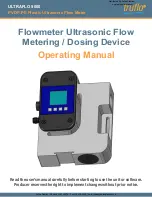
Chapter 2
Cylinder and Components
Edition 1 – December 2019
SAFETY FIRS T
15
MSA G1 Classic Breathing Apparatus
The burst disc is a safety mechanism that has been incorporated into the valve of the
cylinder. It is a sheet of thin metal that is designed to rupture at a specified pressure to
prevent over pressurisation of the cylinder. The burst disk is rated to a nominal burst
pressure of 405 bar and has a tolerance of -35 bar.
The two passive RFIDs are located in the handwheel and the neck of the cylinder.
The 300 bar cylinder will connect to a 200 bar pressure reducer as the
thread sizes are the same (3/4 BSP) but the 300 bar cylinder will not
seal on a 200 bar pressure reducer.
A vent hole is located in the threaded section of 300 bar cylinder valves
to protect 200 bar pressure reducers.
Safe working practices
The cylinder meets all relevant Australian standards.
Do not
drop the cylinder or bump the valve knob and handwheel.
Do not carry or move a cylinder by the handwheel. (Refer to the
Carrying
of cylinders
paragraph later on in this chapter how to correctly carry a
cylinder.)
Only use the handwheel to open and close the cylinder valve.
Remove a cylinder from service and return to the State PPE&C
Management Centre with a fault report if:
it shows evidence of exposure to high heat or flame (such as labels
turned to a brown colour, charred or missing);
it has been dropped or the valve is out of alignment;
it is outside the hydrostatic testing date;
scratches or gouges in the resin layer of the cylinder have displaced
carbon fibres; or
any other damage is suspected.
















































